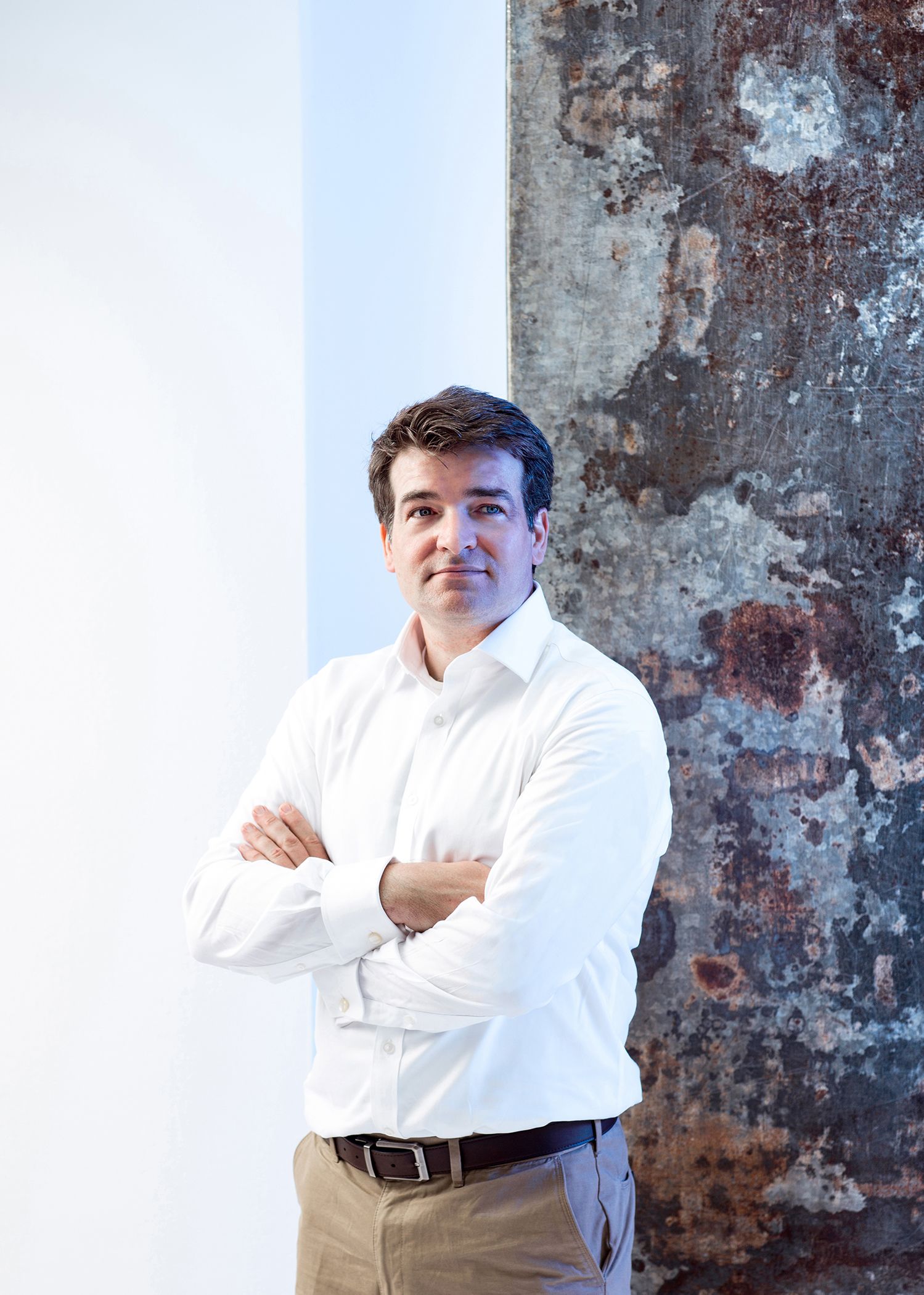Clean reaction
We meet the people who plan to change the world with green chemistry.

From farming and pharmaceuticals to transport and communications, chemistry underpins modern life. But it is also an industry that is too often dirty, dangerous and wasteful.
Dr Florence Gschwend
Recycled wood
When Dr Florence Gschwend (MRes Chemistry 2013, PhD Chemical Engineering 2017) arrived at Imperial, she knew she wanted to use her science for sustainability. But she never anticipated inventing a new process – BioFlex – that could “transform today’s waste into tomorrow’s raw materials” , as she puts it.
In the EU and US alone, around 100 million tonnes of waste wood go unrecycled every year – a major economic loss and an untapped resource. By using ionic liquids as solvents, BioFlex turns waste wood that would otherwise go to landfill into valuable raw materials that can be made into new plastics, glues, bulk chemicals and fuels.
Decarbonising the world's economy means more than ditching fossil fuels
It means that, in the future, BioFlex could be used in anything from biodegradable plastic cups to flat-pack furniture and paints. The process was developed by new spinout company Chrysalix Technologies, founded by Gschwend (now a Research Associate at the Department of Chemical Engineering) with colleagues Dr Jason Hallett and Dr Agnieszka Brandt-Talbot (PhD Life Sciences 2011).
“Decarbonising the world’s economy means more than ditching fossil fuels in favour of renewables like solar and wind energy,” explains Gschwend.
“We need huge quantities of raw materials to produce everyday items and much of this still comes from a barrel of oil.
“Our two innovations are using a cheap solvent and a cheap raw material. The added benefit of using our solvent is that it can extract the heavy metals used as wood preservers, and which remain one of the main barriers to its recycling.”
And because the BioFlex process uses no sulphur, the output materials it generates are free from the rotten-egg smell that prevents the paper industry doing anything useful with its major by-product, lignin.
But what makes BioFlex so special is that it works with any plant material, not only waste wood .
“Plants are made of varying proportions of cellulose, hemicellulose and lignin, but our process works regardless of which plant species you use,” says Gschwend.
“At the moment we’re piloting waste wood, but it could be applied equally well to agricultural residues or invasive species.”
Dr James Wilton-Ely
Palladium metal
Forget gold and platinum: the precious metal we should all be talking about is palladium, a silvery metal used in catalytic converters for many of the 1.2 billion vehicles on the road. But despite being a precious metal, an awful lot of it ends up on the (literal) scrapheap.
Instead of more mining, we need to reuse more of this previous metal
Dr James Wilton-Ely (Chemistry 1994, PhD 1997), Reader in Inorganic Chemistry at the Department of Chemistry, wants to find new ways of recycling these and other extraordinarily useful metals, not least because they are globally scarce and costly to extract.
“Mining is hazardous to workers, local communities and the environment – and palladium mining is no different – so instead of more mining, we need to reuse more of this precious metal,” he says.
Despite its value, recycling palladium from old catalytic converters to make new ones is too expensive. But together with Professor Angela Serpe at the University of Cagliari, Wilton-Ely has developed new ways of reusing this palladium for catalysts in other industries.
Serpe and her colleagues have pioneered a new process capable of separating old catalytic converters into palladium compounds. Rather than using huge amounts of energy to reduce palladium back to the metal, the process uses mild chemicals and small amounts of energy to yield palladium in molecular form. Wilton-Ely’s idea was to find new ways to reuse these valuable compounds.
He’s already discovered that they can be used as catalysts in pharmaceutical research. Here, they perform just as well as existing catalysts – with the added benefit that the palladium is recycled, not newly mined. And having proved they work, Wilton-Ely has extended his work into the myriad reactions based on palladium.
“It’s probably the most catalytic of metals, so it’s widely used in lots of applications. And with some modification, we’ve applied it to lots of routine and industrially important processes that make large quantities of chemical products,” he says.
“It’s a new approach, but in future Angela’s methods could be widely used in industry – and our research will be ready to be rapidly adopted on an industrial scale.”

Dr James Wilton-Ely is finding new ways to reuse precious metals such as palladium.
Dr James Wilton-Ely is finding new ways to reuse precious metals such as palladium.
Henrik Hagemann
Cellulose granules
Next time you drink a glass of water, think carefully about what may have gone into it – every day, millions of people globally are exposed to toxic, manmade chemicals called per- or polyfluoroalkyl substances (PFAS).
Seeing first-hand how industrial chemicals like PFAS have polluted natural environments was part of what motivated Henrik Hagemann (MEng Bioengineering 2015) to find better ways of removing micropollutants from wastewater.
“Travelling through very low-income parts of the world made me want to reduce the impact these chemicals have by tackling the problem at source,” he says.
Together with Gabi Santosa (Life Sciences 2016), Ben Reeve (PhD Bioengineering 2016), Amanda You (PhD Materials 2016) and Shayne Petkiewicz (MSc Chemical Engineering 2016), Hagemann has developed a new way of selectively removing PFAS and other pollutants from wastewater, and set up a new company, CustoMem, to bring it to market.
When you compare using our cellulose-based granules with burning water at 1,100°C, you get an idea of the difference we can make
Their invention is based on simple cellulose. Found in bacteria, algae and across the plant kingdom, it is the most abundant natural polymer in the world. By processing the cellulose and using supramolecular chemistry – how compounds or building blocks are held together by intramolecular bonds – they can produce porous, non-biodegradable granules that can be tailor-made to mop up specific pollutants.
“The granules are hard, non-wetting and look a bit like sand,” explains Hagemann.
“Compared with the activated carbon that’s currently widely used, our materials are novel because not only can they be targeted, they can also be regenerated, so you can reuse our granules on site with a simple non-hazardous liquid wash.”
The end result is a system that is more effective, produces less downstream waste and is much less expensive.
“We’re targeting chemicals that are so persistent that in some cases people currently incinerate water to deal with the problem. When you compare using our cellulose-based granules with burning water at 1,100°C, you get an idea of the difference we can make.”
Instead of having to incinerate water, the team use cellulose-based granules to remove pollutants

Professor Tom Welton
Ionic liquids
If you’ve ever painted a wall, taken your clothes to a dry cleaner or simply made a cup of tea, you’ll have come into contact with solvents. But these essential liquids are often hazardous to health and the environment, and we urgently need to find greener alternatives.
We are finding out how ionic liquids actually behave. Knowing that means that we can manipulate them to achieve a desired outcome
For almost 30 years, chemists have wondered whether ionic liquids – salts that are liquid at room temperature and capable of dissolving almost anything – could be the answer. Despite being hailed as ‘designer solvents’, tailor made for a specific purpose by varying their ions, chemists discovered that behind the hype, the chemistry of ionic liquids was far more complex.
“When I started studying them in 1985, you could put everyone working on ionic liquids in one small room. I know that because it happened – and there were about 30 of us,” says Professor Tom Welton, Dean of the Faculty of Natural Sciences. “Now there are thousands of researchers in a field that’s become very large and hugely exciting.”
What most excites Welton isn’t just that our theories still cannot adequately explain how ionic liquids behave, but that his discoveries have so many potentially world-changing applications. “By developing the tools to study them, we are finding out how ionic liquids actually behave. Knowing that means that we can manipulate them to achieve a desired outcome,” he explains.
Welton is working on real-world applications for ionic liquids alongside his research, such as solutions to the challenges of recycling textiles (it’s currently impossible to recycle polycotton mixtures) and ways of using ionic liquids to dissolve wood, as an alternative to using food crops, which could open up totally new ways of producing biofuels.
“That’s very exciting,” he says. “We’re not there yet, but ionic liquids show huge promise. Something like making biology-based replacements for the oil refinery without using plant foods – now that would have massive global implications.”

Imperial is the magazine for the Imperial community. It delivers expert comment, insight and context from – and on – the College’s engineers, mathematicians, scientists, medics, coders and leaders, as well as stories about student life and alumni experiences.
This story was published originally in Imperial/45: Winter 2018–19.
